| One of
America's most cherished renewable resources. The French
explorers called them Le Dindon sauvage Natives in the Mexican state of Chihuahua (the Raramuri, or Tarahumara), "literally run the birds to death, in what is referred to as persistence hunting. Forced into a rapid series of takeoffs, without sufficient rest periods between, the heavy-bodied bird does not have the strength to fly or run away from the Tarahumara hunter." Ring-necked pheasants are known nest parasites of wild turkeys. There are six subspecies of Meleagris gallopavo. The south Mexican wild turkey (Meleagris gallopavo gallopavo) is one of the smallest subspecies and is best known in Spanish from its Aztec-derived name, guajolote. The south Mexican wild turkey is considered the nominate subspecies and is thought to be critically endangered, as of 2010. The World Bird Database tells us the Mexican wild turkeys geographic range is from Jalisco to Veracruz and south to Guerrero. |
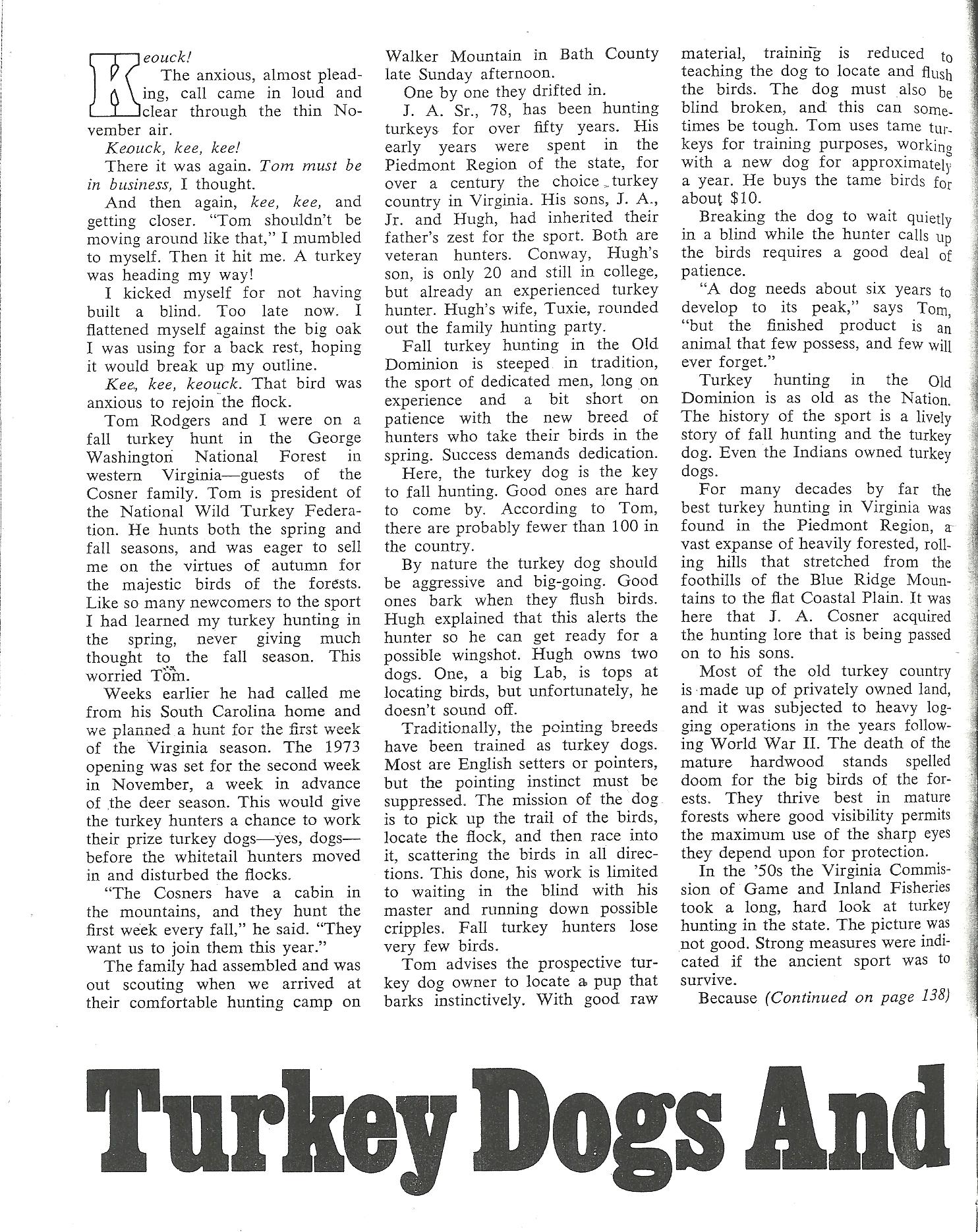 "Fall
turkey hunting in the Old Dominion is steeped in
tradition, the sport of dedicated men, long on experience
and a bit short on patience with the new breed of hunters
who take their birds in the spring. Success demands
dedication." - Bob Gooch, of his 1973 hunt with the Cosner
family (Spotsylvania), on Walker Mountain in Bath County.
Page one of six shown, see last column: "Even the
Indians owned turkey dogs." Members can
read all six here. "Fall
turkey hunting in the Old Dominion is steeped in
tradition, the sport of dedicated men, long on experience
and a bit short on patience with the new breed of hunters
who take their birds in the spring. Success demands
dedication." - Bob Gooch, of his 1973 hunt with the Cosner
family (Spotsylvania), on Walker Mountain in Bath County.
Page one of six shown, see last column: "Even the
Indians owned turkey dogs." Members can
read all six here. |
| They brought him two wild turkeys and a domestic one. The wild turkeys surely weighed 40 pounds each. |
 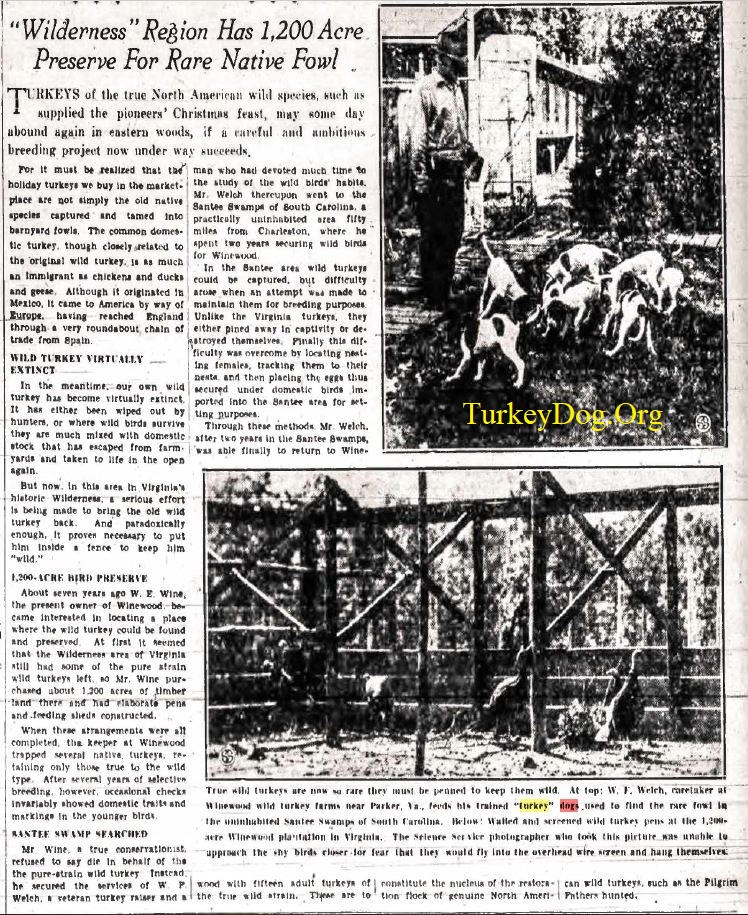 "I was raised in Parker VA,
within walking distance of that farm (Winewood). I
started turkey hunting on that same land my dad and
grandfather did (they knew W. E. Wine). People called
them moss head turkeys, because they had feathers like
peach fuzz on the back of their heads. They didn't talk
much, very hard to call in.
In the 1960's a New York company bought it, put in roads, developed it, it took off big time. I lost 3,000 acres to hunt on when they closed it. Later Joe Gibbs, the head coach of the Washington Redskins bought it. Today it has a golf course, filled with million dollar homes, renamed Fawn Lake, now a gated community." Eddie W. 2/14/21 |
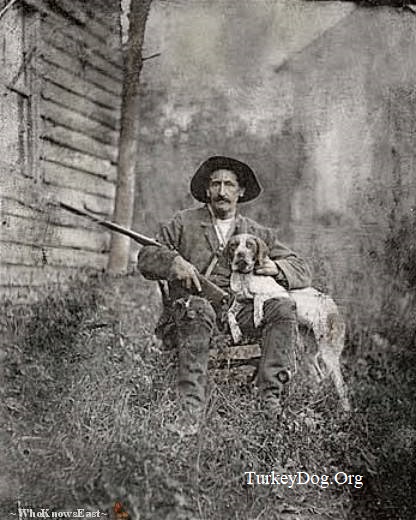 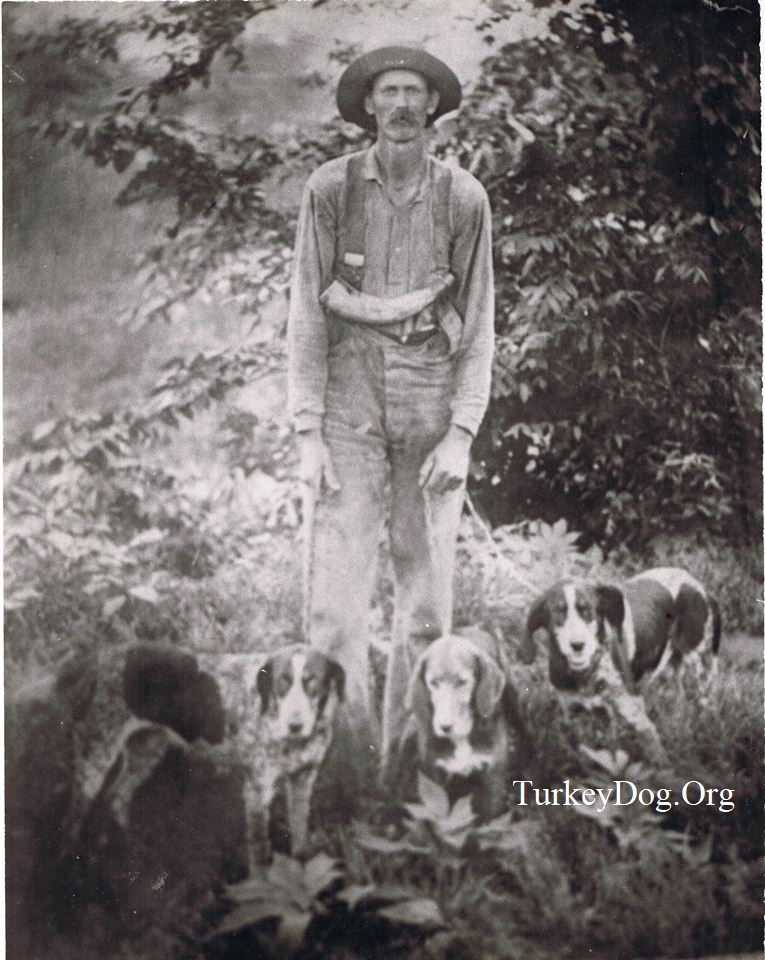 "My
grandfather
was from Charlton county at the southern border of
Georgia. He grew up back in the woods which bordered the
Okefenokee Swamp. He told me that his father had a dog (treeing
walker as I recall) that they would send in to a Tom
that was gobbling in the tree in the morning. The
dog would go in and sit under the tree and the Tom would not fly down
with the dog present, which would allow the
hunter to slip in from the rear and shoot the Tom while
the Tom's focus was on the dog. This would have been circa
1920s. I am not sure of the legality of this practice at
that time but this was done for food purposes in those
days." Joe Dobbins 1/16/22 (Joe plays my kind of music - click
Play All). "My
grandfather
was from Charlton county at the southern border of
Georgia. He grew up back in the woods which bordered the
Okefenokee Swamp. He told me that his father had a dog (treeing
walker as I recall) that they would send in to a Tom
that was gobbling in the tree in the morning. The
dog would go in and sit under the tree and the Tom would not fly down
with the dog present, which would allow the
hunter to slip in from the rear and shoot the Tom while
the Tom's focus was on the dog. This would have been circa
1920s. I am not sure of the legality of this practice at
that time but this was done for food purposes in those
days." Joe Dobbins 1/16/22 (Joe plays my kind of music - click
Play All). |
 Use a Dog to Hunt Fall Turkeys - Subscribe
$12/yr. Use a Dog to Hunt Fall Turkeys - Subscribe
$12/yr.  |
Today most turkey hunters
think Spring is the time to hunt wild turkeys, but Fall is
the traditional time. Our earliest stories of spring
turkey hunting in the United States come from: Rutledge
1907, Jordan/McIlhenny 1914, Turpin 1924, Everitt 1928,
Mosby and Handley 1943, Davis 1949.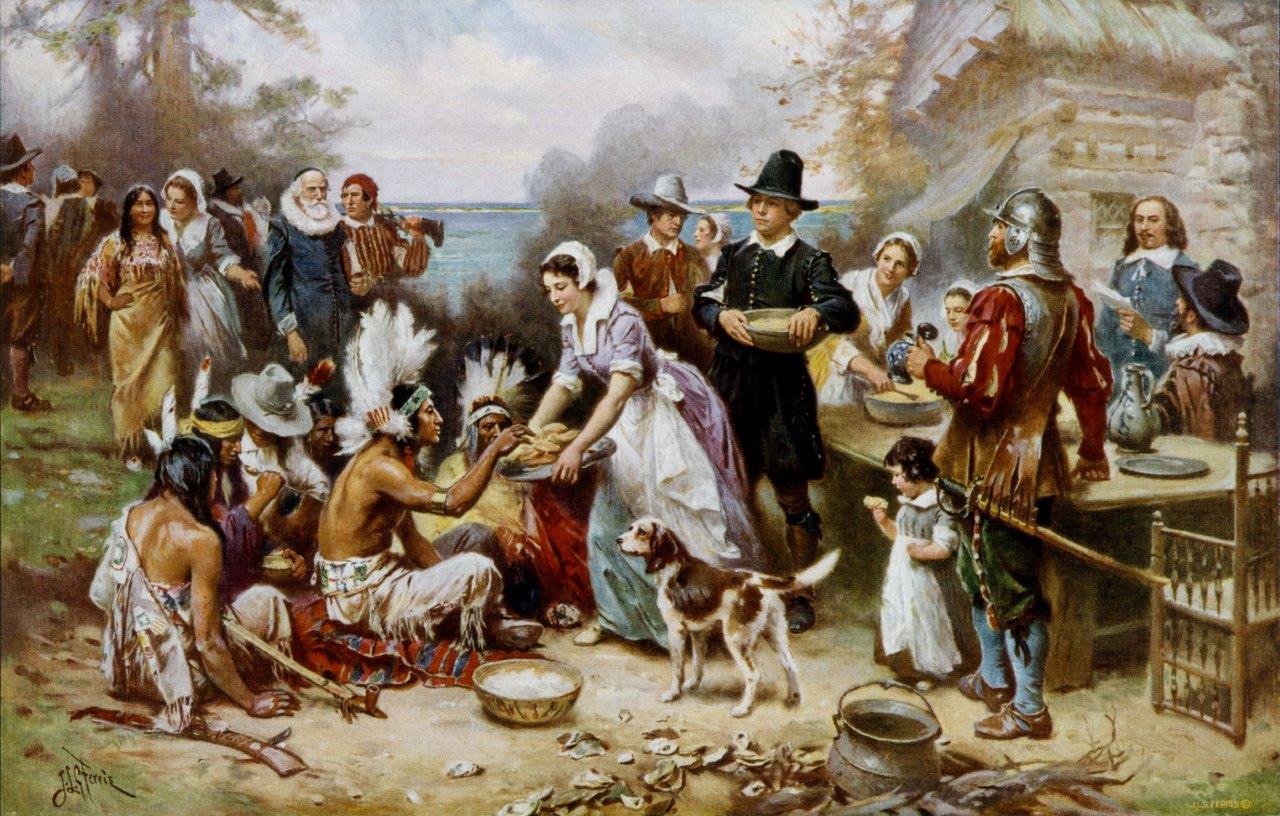 But, Americans were hunting
wild turkey with dogs in the fall since 1621
in Plymouth, Massachusettsa (see the dog in the middle of the painting -
The First Thanksgiving by Jean Leon
Gerome Ferris). Historically, only the first born sons
were granted lands in Britain. The second and third born
sons (and on), were sent to the new world, bequethed
thousands of acres by the king. These British Aristocrats
were the landed gentry, they came here expecting to live
in the style they did at home, with servants to do the
work, while they lived like gentlemen. That included bringing their
beloved quail dogs with them. But they weren't
prepared for the hardships and were soon dependent on the
natives for necessities like food. Since wild turkeys But, Americans were hunting
wild turkey with dogs in the fall since 1621
in Plymouth, Massachusettsa (see the dog in the middle of the painting -
The First Thanksgiving by Jean Leon
Gerome Ferris). Historically, only the first born sons
were granted lands in Britain. The second and third born
sons (and on), were sent to the new world, bequethed
thousands of acres by the king. These British Aristocrats
were the landed gentry, they came here expecting to live
in the style they did at home, with servants to do the
work, while they lived like gentlemen. That included bringing their
beloved quail dogs with them. But they weren't
prepared for the hardships and were soon dependent on the
natives for necessities like food. Since wild turkeys What was turkey hunting with a dog like for the last 400+ years? The breeding and hunting of fine turkey dogs originated in Virginia, still the #1 state for turkey dogs today. These special dogs were bred and hunted in the Tidewater and Piedmont areas of Virginia. Historically, they weren't used in the mountains (Blue Ridge and Appalachians). The British quail dogs became the Virginia turkey dogs. 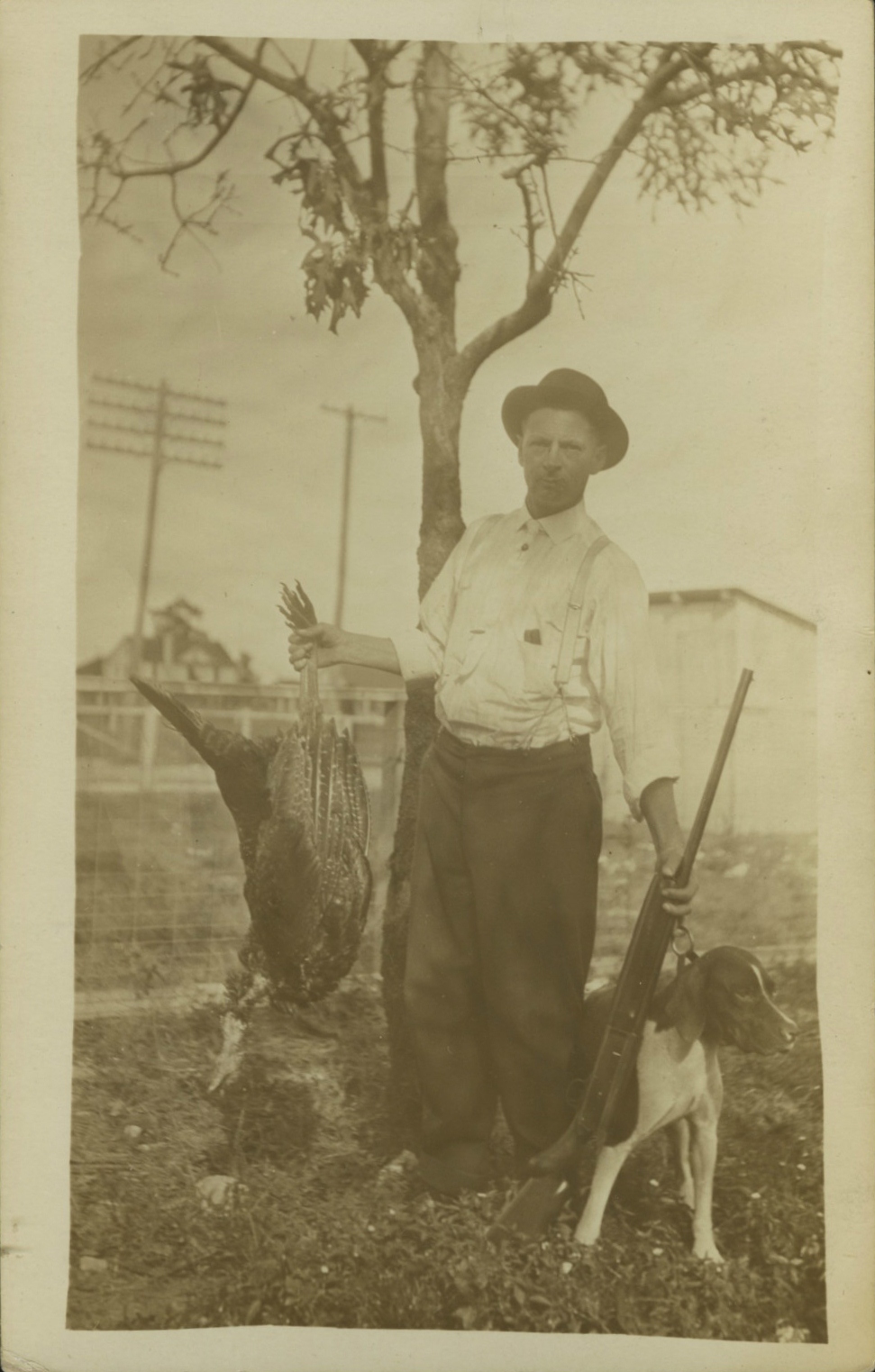 There were dogs in
the New World, long before the arrival of Europeans;
archaeologists have found more than 100 dog skeletons
where woodland Indians lived during the centuries before
Jamestown's founding. There were dogs in
the New World, long before the arrival of Europeans;
archaeologists have found more than 100 dog skeletons
where woodland Indians lived during the centuries before
Jamestown's founding. Now recent archaeological and anthropological studies show it was a longstanding tradition of many native Americans to hunt turkeys in the spring, for the last several thousands of years. Did the immigrants learn spring turkey hunting from the natives? Is that part of the reason the turkey population was decimated (they were hunted year round, but they're most susceptible in the spring), in addition to the introduced European diseases that the turkey had no resistance to? Quoting the recent studies: Passenger pigeons' diet centered on mast, the collective name for acorns, beechnuts, hazelnuts, chestnuts, and the like; they also really liked maize. All were important foods to the Indians of eastern North America. Thus passenger pigeons and Native Americans were ecological competitors. A consulting archeologist in Atlanta... noted that Indians had also vied for mast and maize with deer, raccoons, squirrels and turkeys. Unsurprisingly, they hunted all of them with enthusiasm, as documented by the bones found in archaeological sites. Indeed, Indians actually sought out nursing or pregnant does... They hunted wild turkey in spring, just before they laid eggs (if they had waited until the eggs hatched, the poults could of survived, because they will follow any hen). The effect was to remove competition for tree nuts. The pattern was so consistent, that Indians must have been purposely reducing the number of deer, raccoons and turkeys. Reference: 1491: New Revelations of the Americas Before Columbus ***
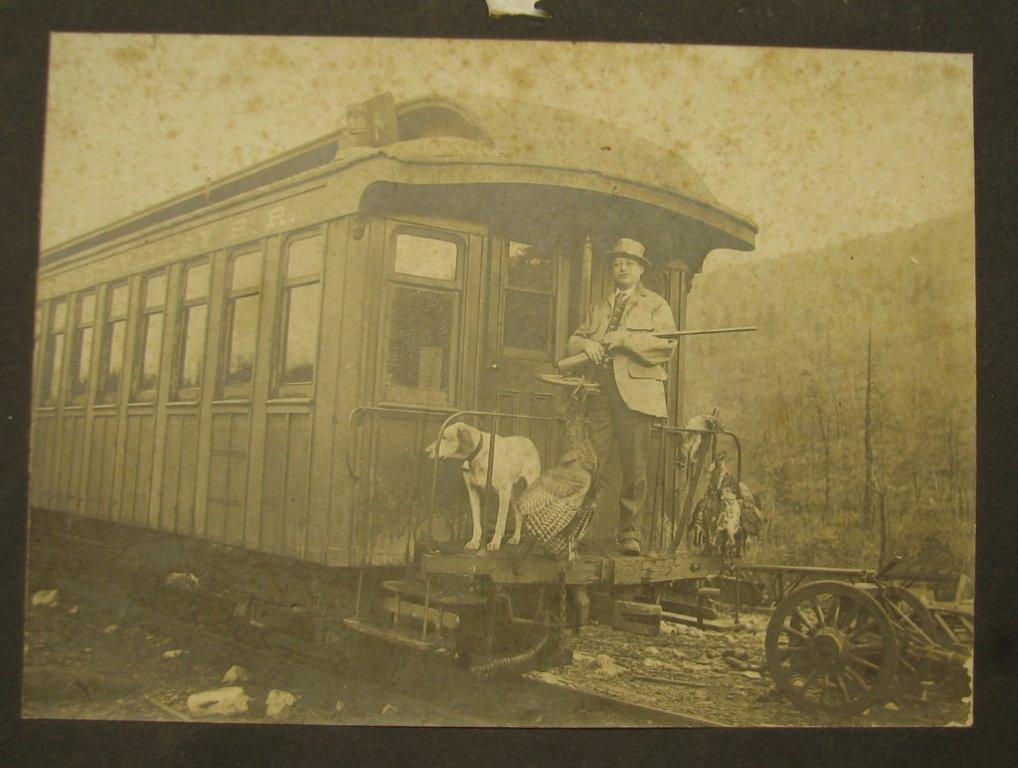 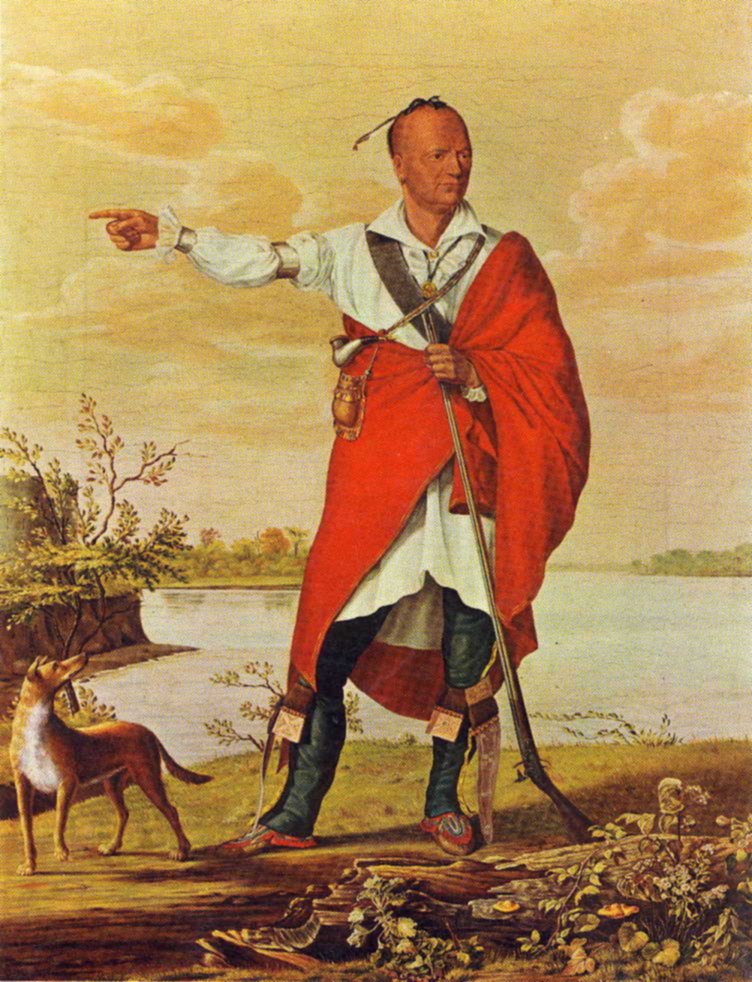 In
precolonial
times (before
Columbus), the natives
in
Virginia used knee-high, 20 pound dogs for hunting
wild turkey (before they interbred with the
large English hunting dogs). The colonists learned
various spring turkey hunting methods from the Indians, as
well as hunting turkeys with a dog (the Powhatans used
their dogs only in hunting land fowl such as wild turkey).
Many tribes kept numerous dogs, these Indians had at least
two
dogs
a piece (members only). In later years, the mix of
hunting dogs in the country would change: "We know from
the historical record that Native Americans had dogs, but
previous population surveys in the Americas turned up only
dogs with European heritage" (National Geographic).
"Genetic evidence suggests that Native Americans and
Europeans domesticated dogs independently, and that North
American pre-contact dogs were almost comple In
precolonial
times (before
Columbus), the natives
in
Virginia used knee-high, 20 pound dogs for hunting
wild turkey (before they interbred with the
large English hunting dogs). The colonists learned
various spring turkey hunting methods from the Indians, as
well as hunting turkeys with a dog (the Powhatans used
their dogs only in hunting land fowl such as wild turkey).
Many tribes kept numerous dogs, these Indians had at least
two
dogs
a piece (members only). In later years, the mix of
hunting dogs in the country would change: "We know from
the historical record that Native Americans had dogs, but
previous population surveys in the Americas turned up only
dogs with European heritage" (National Geographic).
"Genetic evidence suggests that Native Americans and
Europeans domesticated dogs independently, and that North
American pre-contact dogs were almost comple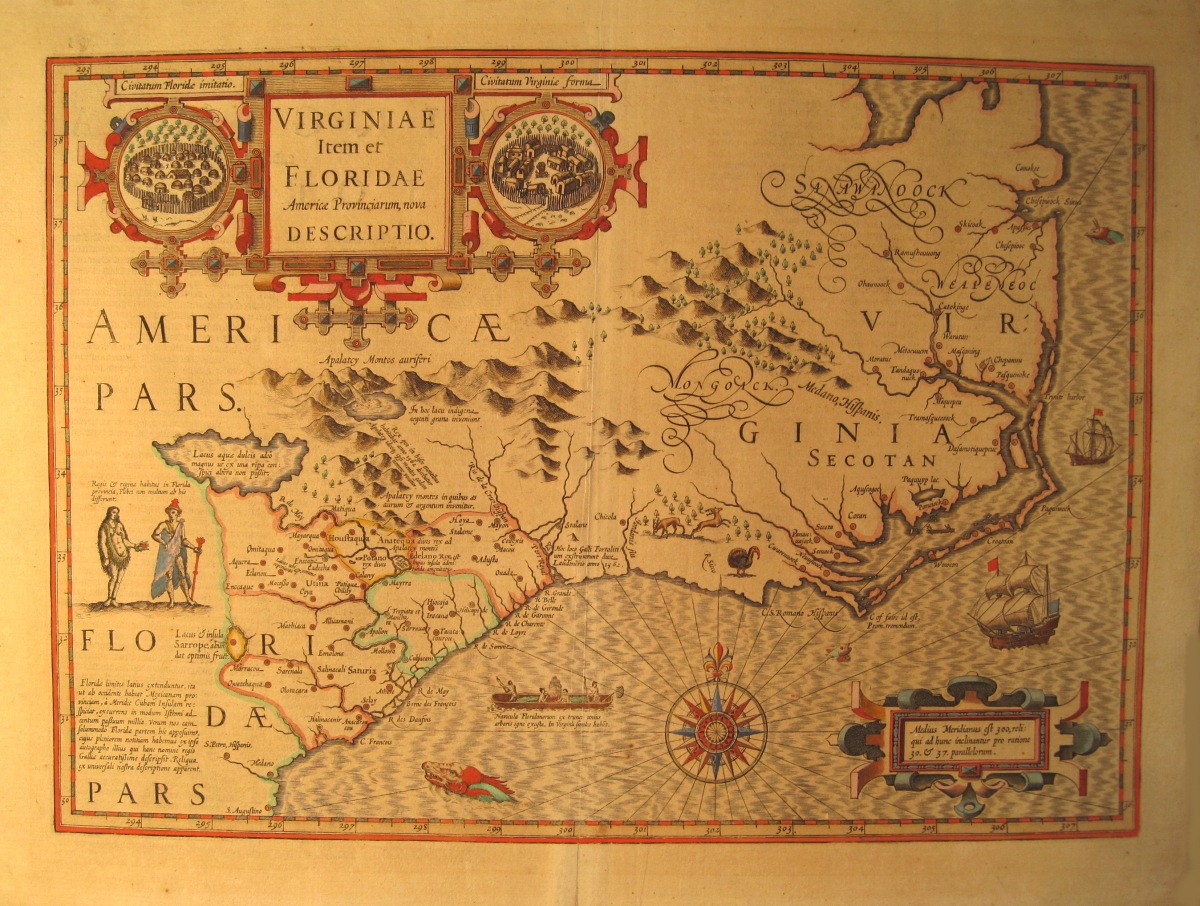 tely replaced by
dogs that came over on European ships" (Canadian
Museum
of Nature). "What we know about dogs in
Native American societies is limited. But we do know
that the dogs brought by the Spanish were much different
in character and breeding from those already present" A
History of Dogs in the Early Americas tely replaced by
dogs that came over on European ships" (Canadian
Museum
of Nature). "What we know about dogs in
Native American societies is limited. But we do know
that the dogs brought by the Spanish were much different
in character and breeding from those already present" A
History of Dogs in the Early Americas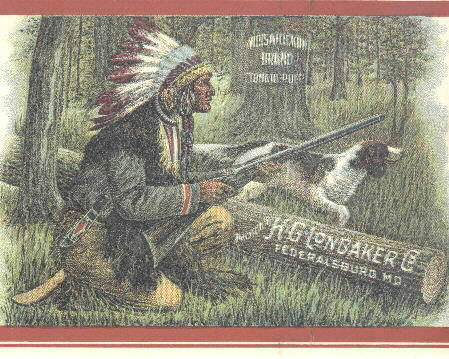 In
Connecticut, it was forbidden for Indians to have European
dogs: 'It is ordered by this Courte and Authority thereof,
that no man within this Jurisdiction shall... sell, barter
or give to any Indian...any dog or dogs, small or great;
upon pain of ten pounds fine for every offense...'
Connecticut Code of Laws 1650 In
Connecticut, it was forbidden for Indians to have European
dogs: 'It is ordered by this Courte and Authority thereof,
that no man within this Jurisdiction shall... sell, barter
or give to any Indian...any dog or dogs, small or great;
upon pain of ten pounds fine for every offense...'
Connecticut Code of Laws 1650******************************************************************************************
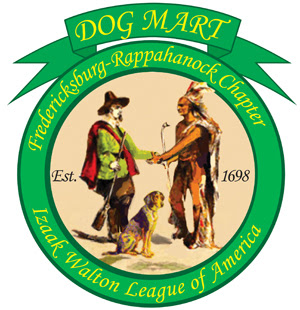 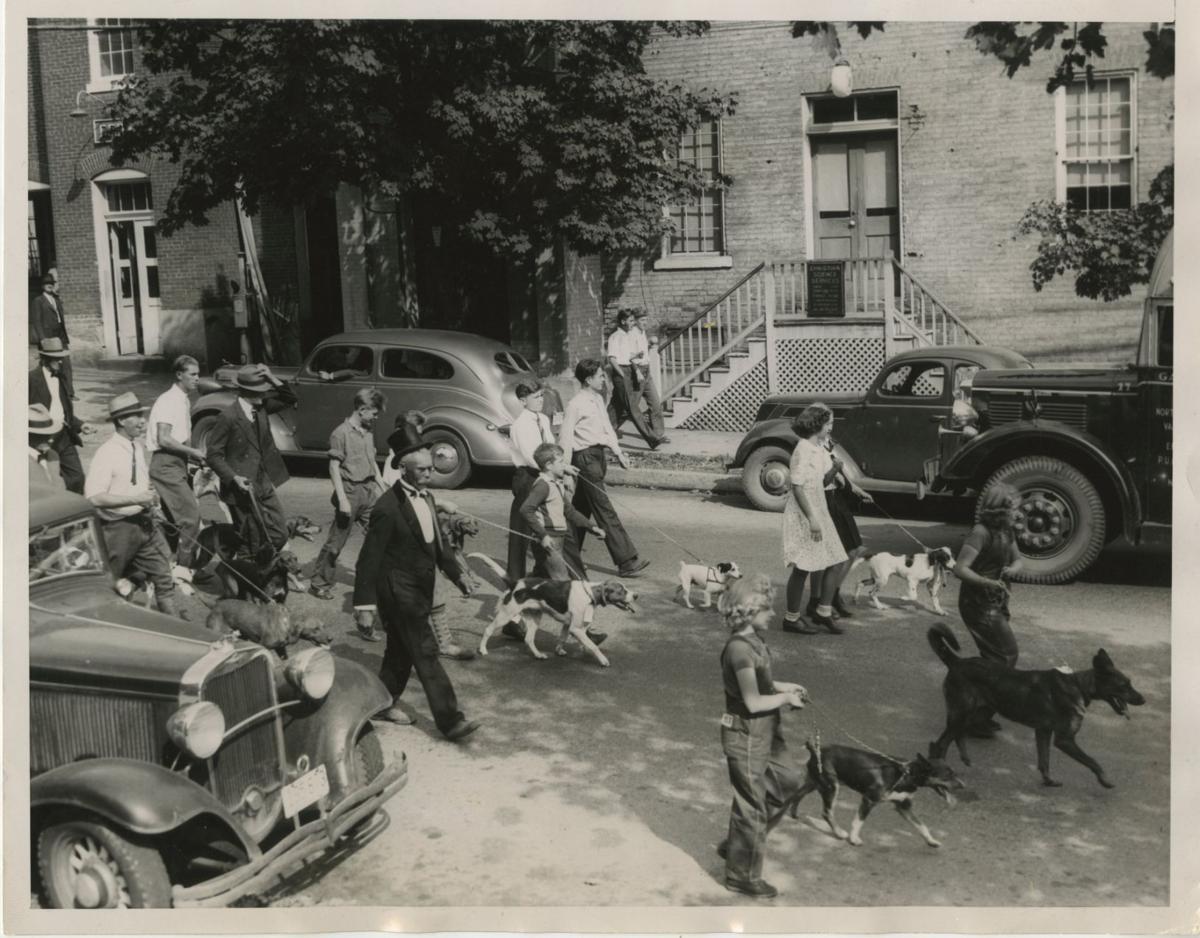 Same
for
Virginia in 1617, until 1677. But since 1698, at the Fredericksburg, Virginia Dog
Mart Indians bartered for European hunting
dogs. Fredericksburg became the site of an annual
dog-trading tradition between Europeans and Indians that
would last until the Revolutionary War. Then again from
1927 until 1941, then it stopped for WWII, then resumed in
1948 until the present. In 1980, the dog mart was held without
dogs, because of a canine parvo epidemic. In 2020, it's cancelled because of the human
pandemic. Same
for
Virginia in 1617, until 1677. But since 1698, at the Fredericksburg, Virginia Dog
Mart Indians bartered for European hunting
dogs. Fredericksburg became the site of an annual
dog-trading tradition between Europeans and Indians that
would last until the Revolutionary War. Then again from
1927 until 1941, then it stopped for WWII, then resumed in
1948 until the present. In 1980, the dog mart was held without
dogs, because of a canine parvo epidemic. In 2020, it's cancelled because of the human
pandemic.There is no charge for buying or selling a dog; the only rule is that a dog can be placed on the auction block only once. Some dogs go free to the children who first appear at the block to claim them. ******************************************************************************************
"Interestingly, there are over four hundred dog breeds today, and most of them were developed in just the last 150 years." "The data also confirm the idea that dogs moved with humans from Asia into the New World and were not domesticated from scratch with wolves in North America. The large majority of breeds, however, likely have recent, European origins, according to the authors." 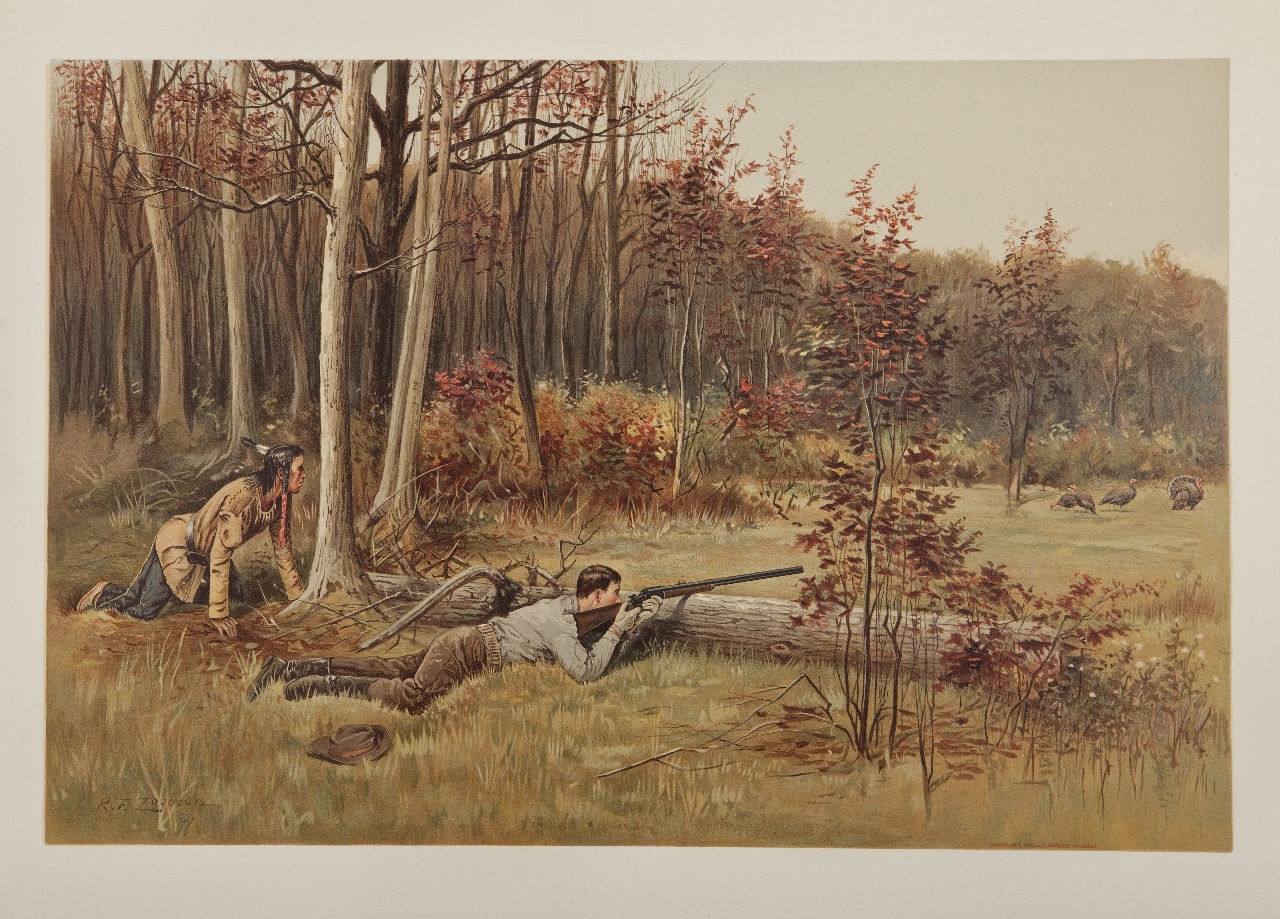 Most breeds of dogs
are at most a few hundred
years old, but the English
Setter appeared about 400 years ago in England. The
English
Pointer may have been around since 1650. Many turkey
dogs are part Plott
hound, a breed that originated in the mountains of
western North Carolina about 1800, and is also the state
dog of North Carolina. Most breeds of dogs
are at most a few hundred
years old, but the English
Setter appeared about 400 years ago in England. The
English
Pointer may have been around since 1650. Many turkey
dogs are part Plott
hound, a breed that originated in the mountains of
western North Carolina about 1800, and is also the state
dog of North Carolina.Who started hunting turkeys with dogs? Did the Jamestown VA immigrants learn it in the sacred hunting grounds of the Indians and their dogs that survived the period? Soon after, the Europeans imported hunting dogs. Virginians refined turkey hunting with a dog and kept the tradition alive for the next 400 years. See the source cited by the 1491 book and read more about the origin of the Turkey Hunting Dog. 1890 Wild Turkey Hunt with Indian Guide photo by special permission of the Smithsonian Institution, National Museum of American History, Home and Community Life, Harry T. Peters 'America on Stone' Collection (Image Use | Copyright | Credits). 1606 Apalatchy VA map credit: Jodocus Hondius [1606]-1636 Amsterdam. Old turkey dog hunter and Valley RR photos courtesy Steve Turpin. |
| Our ability to perceive quality in nature begins, as in art, with the pretty. It expands through successive stages of the beautiful to values as yet uncaptured by language. Aldo Leopold, A Sand County Almanac |
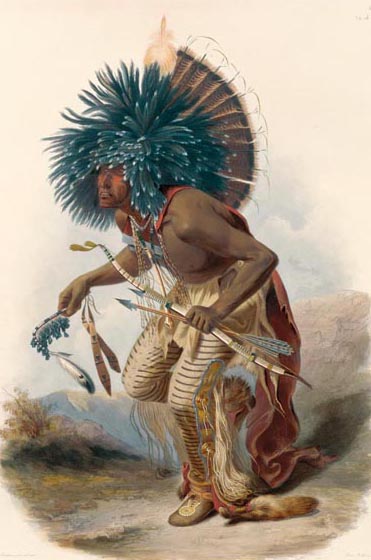 The
women of the Caddo Indian tribe perform the first four
parts of the hour long Turkey Dance. The
women of the Caddo Indian tribe perform the first four
parts of the hour long Turkey Dance. Turn up the speakers. The Caddo Nation 5 part turkey dance. The Zuni Indian turkey dance at the Albuquerque Indian Cultural Center. In 1834, Karl Bodmer illustrated the Hidatsa Warrior - Two Ravens Hand-coloured aquatint engraving by Rene Rollet after Bodmer was offered by William Reese Company for $60,000.00 |
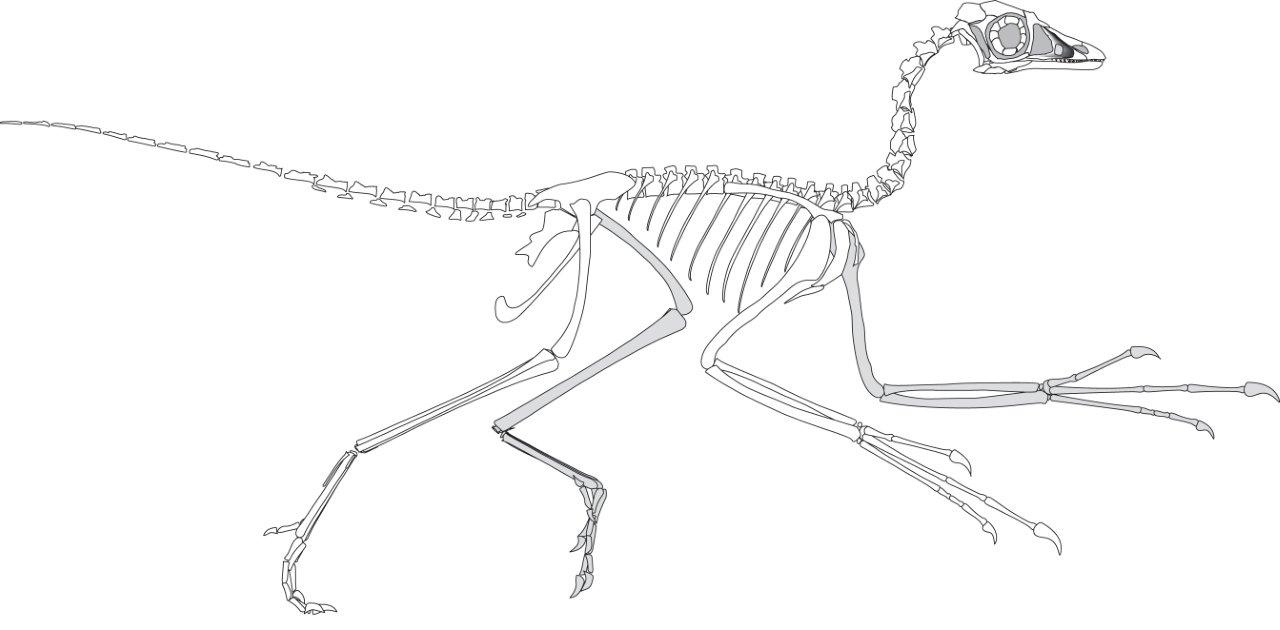 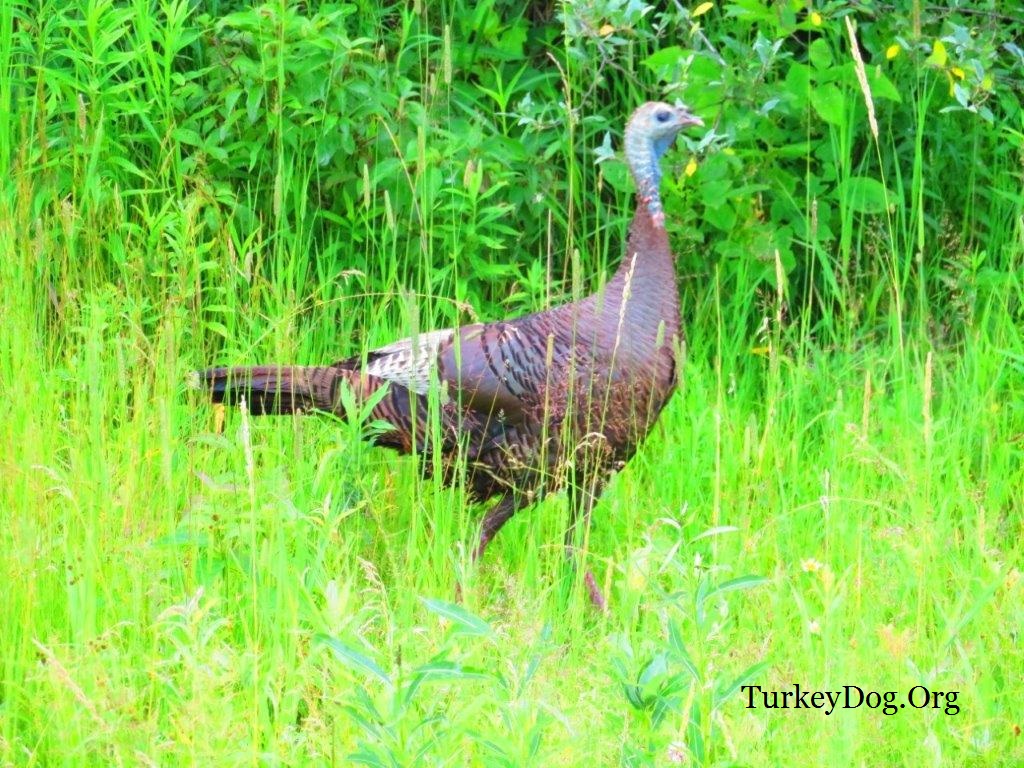 We hunt wild turkeys
with similarities in bone structure to the hollow-boned
dinosaurs. Imagine you're hunting this ancient bird, the
feared velociraptor. Whose main
characteristics include three toes facing forward, scales
on its legs, a backbone parallel to the ground and its
neck is S-shaped. Will this theropod
be your familys thanksgiving dinner, or will you be the
raptors? Another 160 million year old forest dwelling
bird-like creature named Aurornis, lived in the Jurassic and
Cretaceous times before Archaeopteryx, looks like the
ancestor of todays wild turkey. We hunt wild turkeys
with similarities in bone structure to the hollow-boned
dinosaurs. Imagine you're hunting this ancient bird, the
feared velociraptor. Whose main
characteristics include three toes facing forward, scales
on its legs, a backbone parallel to the ground and its
neck is S-shaped. Will this theropod
be your familys thanksgiving dinner, or will you be the
raptors? Another 160 million year old forest dwelling
bird-like creature named Aurornis, lived in the Jurassic and
Cretaceous times before Archaeopteryx, looks like the
ancestor of todays wild turkey....chickens and turkeys are genetically the closest dinosaur relatives (The Wonder of Birds by Jim Robbins) |
| National Geographic - Man and Dog an Evolving
Partnership (49 minutes), used to be available at Hulu. |
|
The Wild Turkey Population Dynamics Research Project transcript available upon request. Photos courtesy Steve Turpin. |
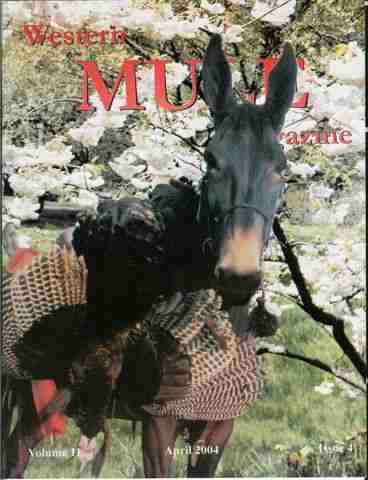 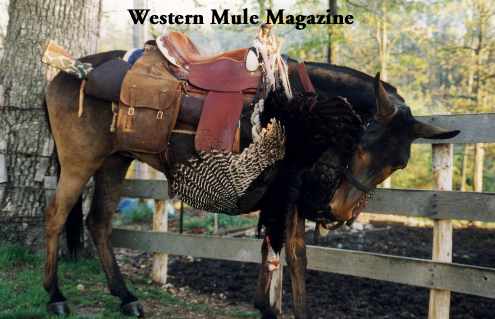 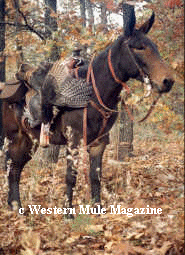 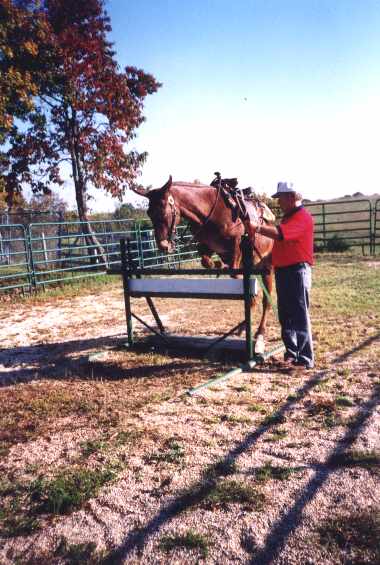 Ben Tennison of Western Mule Magazine hunts turkeys in the fall with his Missouri Jumping Mule. "When I see a flock across a field I just ride slowly towards them. Generally the flock will go into the woods where they're all bunched up. That's when I run my mule at them full speed, and if we get a good scatter, I tie up my mule a ways away, sit down and call the flock back. It doesn't always work, but it sure beats trying to run at them myself, especially at my age." Ben fully agrees Missouri should allow dogs in the fall. Photos Western Mule Magazine. Starting in the fall of 2005 Missouri will have a longer season, and hunters can take both birds the same day. |
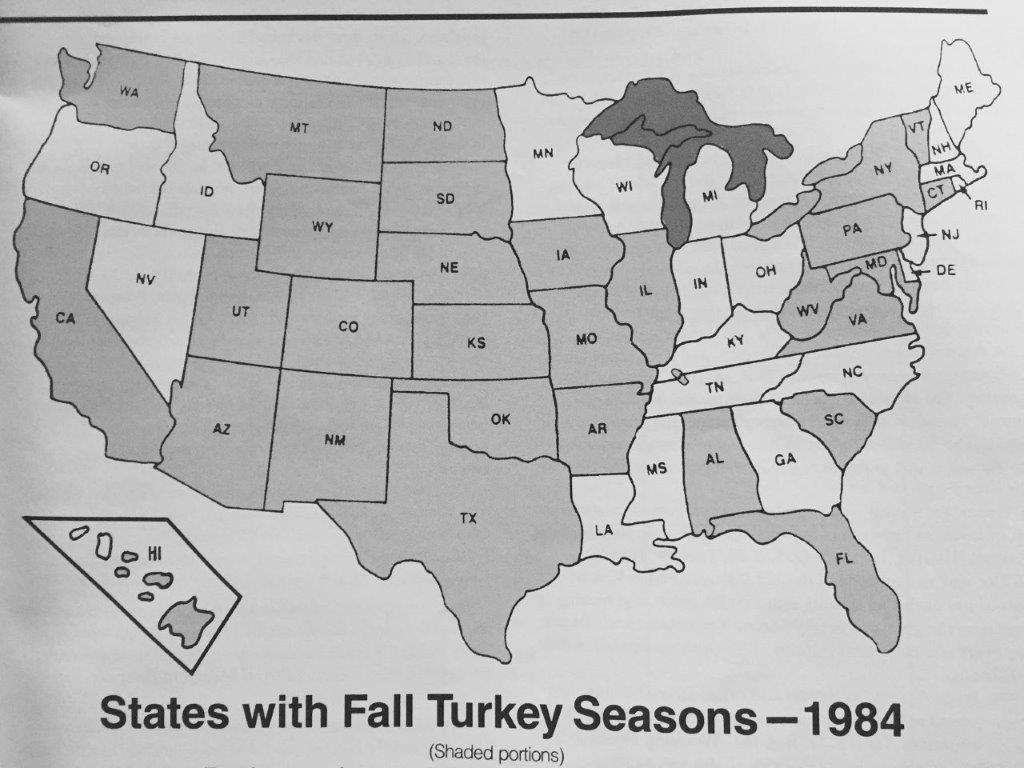 "The
hens
have recovered their flesh which they had lost by sitting,
the gobblers have regained their plumpness by feeding upon
nuts, grapes, and a thousand and one good things picked up
in the forest. When all are fat and strong they gradually
form themselves into flocks, or gangs as the forest
settlers and hunters call them, frequently as many as a
hundred birds being in one group. This feathered '
gathering of the clans' has given the Indians their name
for the month of October, which they call Turkey month." "The
hens
have recovered their flesh which they had lost by sitting,
the gobblers have regained their plumpness by feeding upon
nuts, grapes, and a thousand and one good things picked up
in the forest. When all are fat and strong they gradually
form themselves into flocks, or gangs as the forest
settlers and hunters call them, frequently as many as a
hundred birds being in one group. This feathered '
gathering of the clans' has given the Indians their name
for the month of October, which they call Turkey month." "But there is another kind of sport better suited to the winter months before the gobblers would answer a call: and that is, hunting them with a properly trained turkey dog. A well-trained dog will never range very far from his master till he finds the warm scent of a single turkey or a flock. Then he will start upon the trail without giving tongue until he finds the game. He will then run on, and by continual yelping, compel it to ascend some tree." 1866 A Hunter's Experiences in the Southern States of America |
There are a great many in the same place, but he could do nothing without a dog." M. Le Page Du Pratz, The History of Louisiana 1724. Receive a Native American Name for your new turkey dog, from 47 Indian Tribes. |
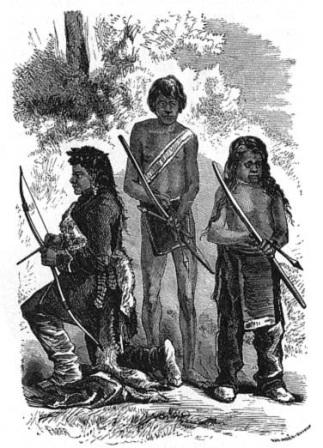 "Some
tribes did not consider turkeys enough of a challenge or
delicacy to warrant the attention of experienced hunters,
but they encouraged children to hunt them They did so in
various ways, an unusual one being a dart blown through a
nine-foot-long reed. Some youngsters became proficient
enough to kill a turkey at thirty feet." Memoirs,
official
and personal: With sketches of travels among the
northern and southern Indians : embracing a war
excursion, and descriptions of scenes along the western
borders "Some
tribes did not consider turkeys enough of a challenge or
delicacy to warrant the attention of experienced hunters,
but they encouraged children to hunt them They did so in
various ways, an unusual one being a dart blown through a
nine-foot-long reed. Some youngsters became proficient
enough to kill a turkey at thirty feet." Memoirs,
official
and personal: With sketches of travels among the
northern and southern Indians : embracing a war
excursion, and descriptions of scenes along the western
borders |
| Yet in 1804 to 1806, the
Lewis & Clark Expedition ate 1001 Deer, 375 Elk, 227
Bison, but only 9 turkeys. The turkey population may have
succumbed to blackhead, from the introduction of chickens
into the new
world. George Catlin participated in a Sioux Indian ceremony of friendship at which a meal of dog meat was the center of the festivities... Long's men observed how their host treated the cooked dog carcasses with reverence, each bone being meticulously cleaned in preparation for burial. The Sioux buried the bones to show respect for the species and to encourage more dogs to come into the world... The Indian sees fit to sacrifice his faithful companion to bear testimony to the sacredness of his vows of friendship. |
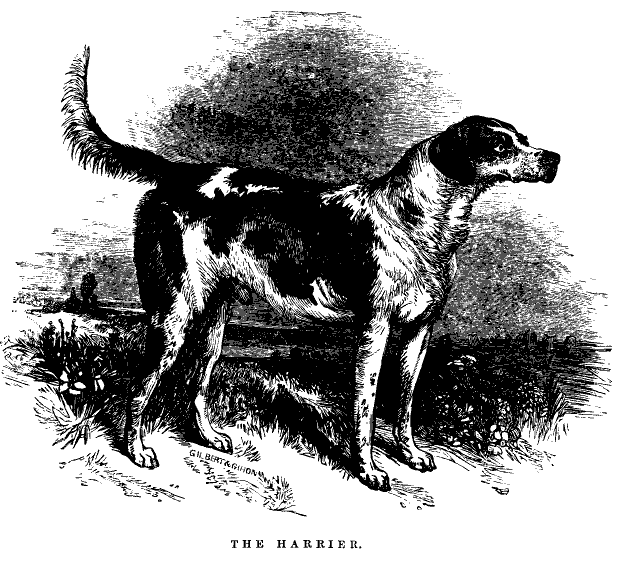 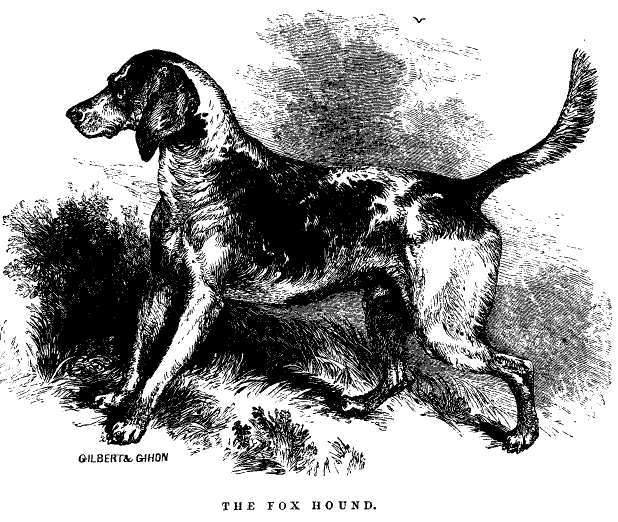 "In the early 1900's hunting turkeys
with dogs in Alabama was a legal and accepted way to
hunt, and pretty much the standard at that time." Uncle
Roy Moorer told me, "A man had rather be caught rustling
cattle, than shooting a turkey on the ground and not
flushing it first, and giving it a sporting chance to
escape." John E. Phillips "In the early 1900's hunting turkeys
with dogs in Alabama was a legal and accepted way to
hunt, and pretty much the standard at that time." Uncle
Roy Moorer told me, "A man had rather be caught rustling
cattle, than shooting a turkey on the ground and not
flushing it first, and giving it a sporting chance to
escape." John E. Phillips Read about Alabama's turkey dog history in John's Outdoor Life Complete Turkey Hunting |
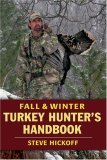 Outdoor writer Steve Hickoff travels from Maine to New York to hunt turkey with his dog. Update March 2006 NH is proposing a fall shotgun hunt, details on the Legislation page. UPDATE June 2007! DOGS ARE NOW ALLOWED during the NH fall turkey season. Update August 2007: A new fall shotgun season and with dogs approved in Maine for fall 2007. Steve's latest book features dogs, and is a must read: Fall and Winter Turkey Hunter's Handbook Maine 2013 - Here's a photo of one of our many successful fall hunts. L to R - son Tim Wescott, GSP Gunny (age 2), Niles Oesterle. Target species in foreground. Gunny had 19 scatters in 2012 as a pup. Didn't try to keep track in fall 2013. Maine season was four weeks long with two bird bag limit. We hunted and/or guided all but two days..... so there's room for improvement ;-) Love the Turkey Dog News! Jim Wescott Tenth Legion Guides Maine From 2013 to 2020, in Maine and New Hampshire! GSP Gunny and English cocker Henry having a great time chasing northern New England flocks. Gunny was in the NWTF Turkey Country September/October 2020. Our old Damascus Parker hammerguns have had warm barrels all fall. Happy Thanksgiving. Jim Wescott, Maine  Tenth
Legion
Guide Robb Cotiaux with fall gobbler and 9 year old
GSP Gunny (gun is an 1880 Parker underlifter 12
gauge Damascus). Tenth
Legion
Guide Robb Cotiaux with fall gobbler and 9 year old
GSP Gunny (gun is an 1880 Parker underlifter 12
gauge Damascus).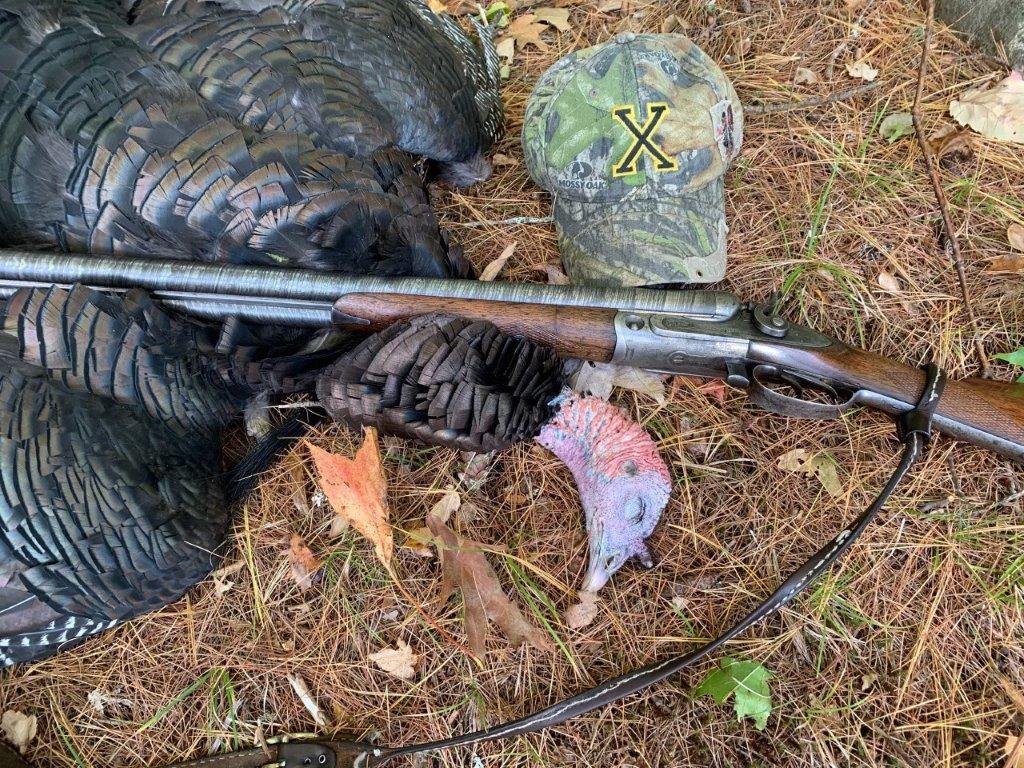 Another
fall
gobbler with another 1880 Parker 32 Damascus. Another
fall
gobbler with another 1880 Parker 32 Damascus.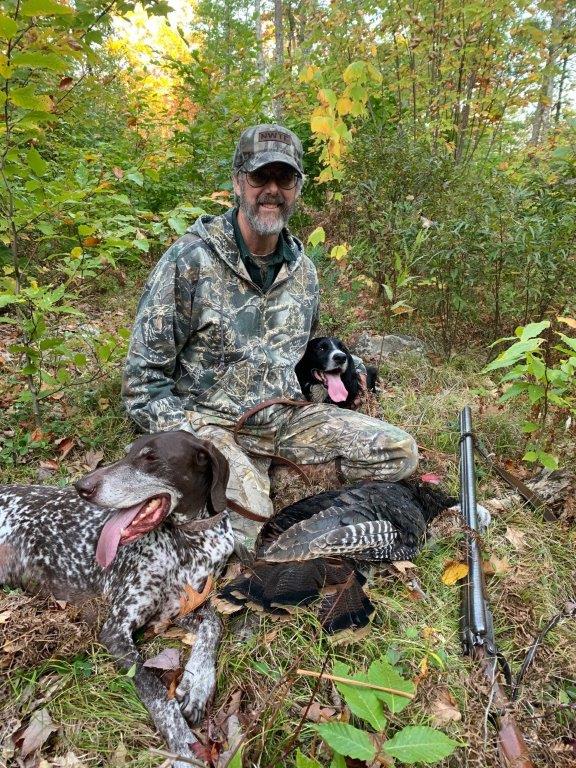 Connecticut
wild
turkey biologist Mike Gregonis with 5 year old
Henry, Gunny and jenny. Connecticut
wild
turkey biologist Mike Gregonis with 5 year old
Henry, Gunny and jenny.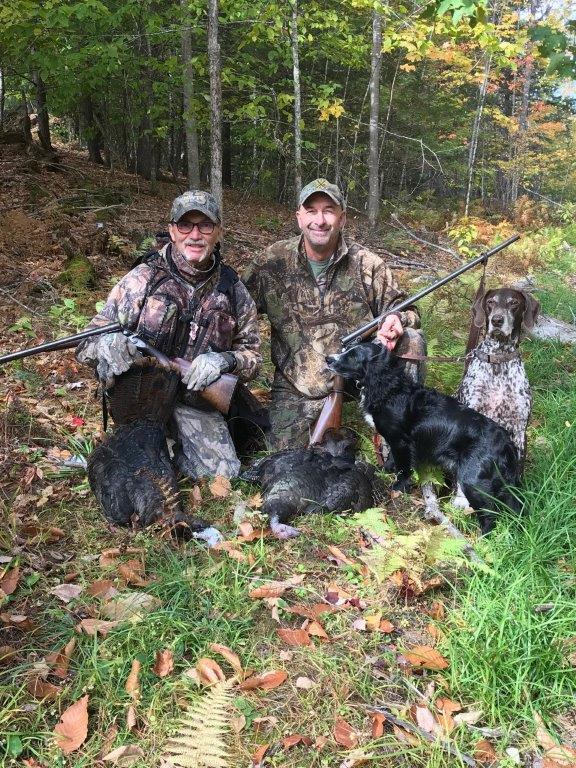 Fine New Hampshire morning, excellent bust and classic call back of two Granite State jakes. (Robb on left, yours truly on the right) 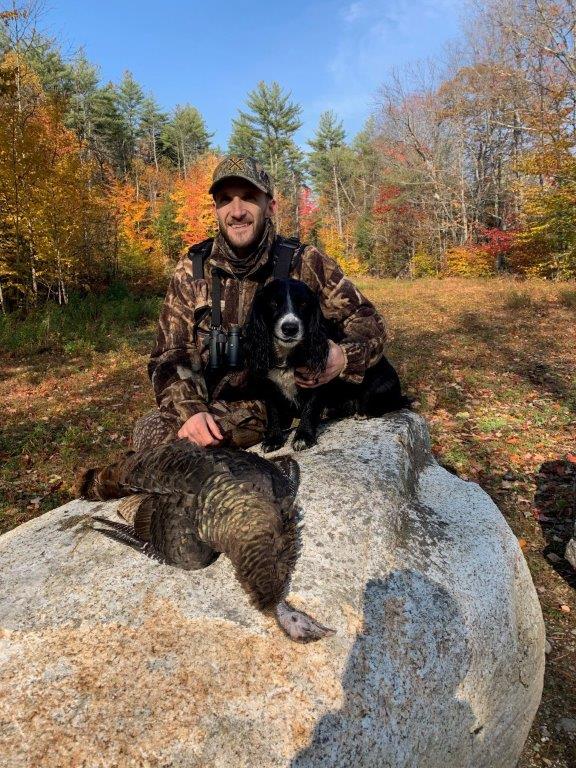 Son
Tim
Wescott with Henry and a New Hampshire jenny. Tim
totes an 1878 Parker. Gunny would not get up on the
boulder. These two turkey dogs work very well
together, far ranging Gunny and medium range Henry. Son
Tim
Wescott with Henry and a New Hampshire jenny. Tim
totes an 1878 Parker. Gunny would not get up on the
boulder. These two turkey dogs work very well
together, far ranging Gunny and medium range Henry. The Parkers range from 0 grade to grade 2 and cost from $350 - 2,500, depending on condition, originality etc. The less expensive are great finds or need some work. They are all 30 yard guns with some capable of a little more. I ve owned ten Parkers, all Damascus hammerguns over 140 years old, 12 gauges chambered 2 5/8 . My hunting buddies have a great interest in them also. I reload black powder shells in full length brass or once-fired paper. My best guns have birds and setters engraved on the sides and floor plate, some have no engraved animals. As you can imagine they are a blast to shoot and add so much to the hunt. I ve been hunting turkey with Parkers for 20 years and turkey dogging for the last 12. Thank you for putting so much great information on the AWTHDA. Jim Wescott, Maine 11/6/20 |
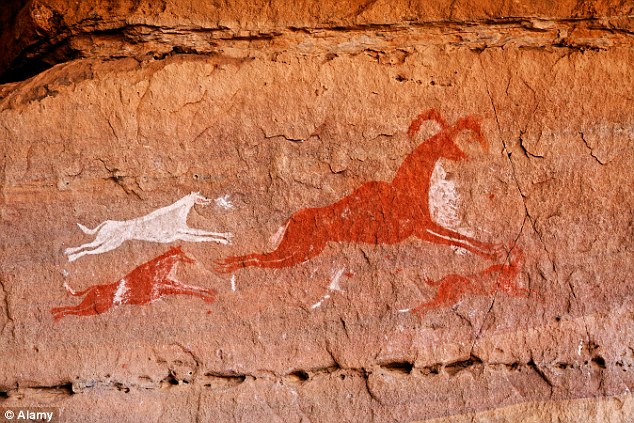 A
hundred years ago, you could get arrested, or fired,
for doing the Turkey Trot. A
hundred years ago, you could get arrested, or fired,
for doing the Turkey Trot. Since 1987, it gets a lot more outrageous than that at Turkey Trot Acres, the NorthEast's Premier Hunting Lodge. |
'Indian children had to learn the different calls of the turkey, to communicate among hunting and war parties.' Samuel Kercheval A HISTORY OF THE VALLEY OF VIRGINIA A history of the valley of Virginia |
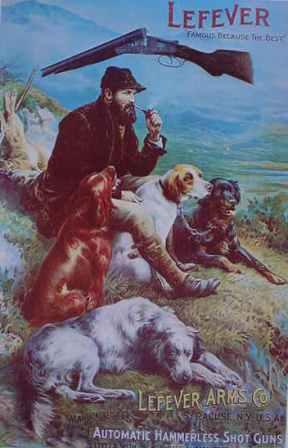 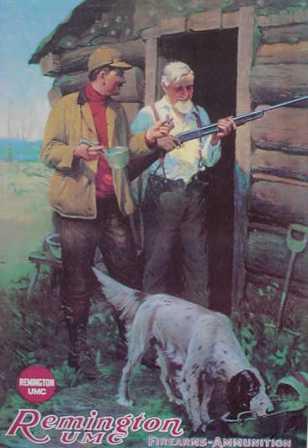 "In some states... hunting
turkeys during the fall is a bigger tradition than
hunting them in the spring. Most southerners would
classify fall turkey hunting as a northern or Yankee
tradition... The bottom line is that fall turkey hunting
can be a lot of fun without harming turkey populations.
Fall turkey seasons are a great opportunity to introduce
youth hunters to the sport that we all enjoy so much." "In some states... hunting
turkeys during the fall is a bigger tradition than
hunting them in the spring. Most southerners would
classify fall turkey hunting as a northern or Yankee
tradition... The bottom line is that fall turkey hunting
can be a lot of fun without harming turkey populations.
Fall turkey seasons are a great opportunity to introduce
youth hunters to the sport that we all enjoy so much."Fall Turkey Hunting: Chasing that Elusive "Thanksgiving Butterball" By James Austin and Ron Seiss (see last page of the pdf). Mississippi expands their area for the fall 2006 turkey hunt, but dogs are not allowed. See details on the Legislation page. |
  Pennslvania raised more turkeys for
release than anywhere, and for years you couldn t use a
call or a blind in the fall. Hunting turkeys in
Pennslvania in the fall is a longer tradition than in
the spring (it was closed for 95 years). All of which
makes it particularly odd they don't allow dogs, and now
they're surrounded by States that do! And as of 2006 you
can take a 2nd gobbler in the spring, but still only one
bird in the fall, and not with a dog. Pennslvania raised more turkeys for
release than anywhere, and for years you couldn t use a
call or a blind in the fall. Hunting turkeys in
Pennslvania in the fall is a longer tradition than in
the spring (it was closed for 95 years). All of which
makes it particularly odd they don't allow dogs, and now
they're surrounded by States that do! And as of 2006 you
can take a 2nd gobbler in the spring, but still only one
bird in the fall, and not with a dog. As of June 30, 2007, after 15 months of hard lobbying by the PA chapter of the AWTHDA, PA once again allows turkey hunting with a dog, like they did in the 1800's. |
Memoirs of Lieutenant Henry Timberlake (The First American Frontier) by Henry Timberlake. The Cherokee Chief Standing Turkey went with Henry Timberlake to London in 1762-1763. Standing Turkey's nephew, Chief Stalking Turkey, was half Shawnee and half Cherokee. (The Native Americans used many techniques for hunting or capturing wild turkeys. Unlike the wild turkey of today, the birds were unwary of humans and easily captured. The Wild Turkey: Biology & Management by James G. Dickson) Photo courtesy Steve Turpin. |
  'Coursing turkeys
with greyhounds, as practiced in the more open 'Coursing turkeys
with greyhounds, as practiced in the more open western country is exciting sport... Well-trained turkey dogs are useful in chasing winged birds, which a man could never catch.' Audubon (1840) 'The Californian and Texan horsemen course hare, antelope, and wild turkey with their fleet greyhounds.' Theodore Roosevelt - Hunting Trips of a Ranchman 1885. |
 Chapter
Fourteen - A Wild-Turkey Hunt (from the 1800's): Chapter
Fourteen - A Wild-Turkey Hunt (from the 1800's): "We can run them as we were about to do had they been buffaloes. Ha! ha! ha! laughed Fran ois; run a turkey! Why it will fly off at once. What nonsense you talk, brother! I tell you, no, replied Basil. It is not nonsense it can be done I have often heard so from the trappers, now let us try it ourselves. ... He saw the dog standing by the root of a large oak. He had treed the turkey, and was looking upward with glancing eyes, barking and wagging his tail. The Boy Hunters by Captain Mayne Reid (1818-1883). |
  In Audubon's time, he couldn't find a single wild turkey in some areas of the Northeast. Today, Connecticut has 40,000 turkeys. New biography - John James Audubon : The Making of an American |
 While a Southern tradition
back in the old days, today hunting turkeys with dogs in
the fall or winter is no longer allowed in AL, AR, FL, GA,
LA, or SC. Now, most of these states allow hunters to
shoot up to five gobblers in the spring, and don't even
have a fall or winter season! While a Southern tradition
back in the old days, today hunting turkeys with dogs in
the fall or winter is no longer allowed in AL, AR, FL, GA,
LA, or SC. Now, most of these states allow hunters to
shoot up to five gobblers in the spring, and don't even
have a fall or winter season!This photo (from a wood-engraved illustration made from the artists sketch) depicts fall/winter turkey hunting with a dog. One hunter keeps the dog still, while the other calls to the regrouping turkeys. Turkeys in the trees are pitching down to ones on the ground. "Yelping Up Wild Turkeys" from the 1/10/1885 Harper's Weekly (A Journal of Civilization), drawn by W.L. Sheppard (1833-1912). Photo courtesy of America's Oldest Name in Custom Calls |
'American Indians would attract the gobbler by placing a decoy, then hiding behind logs and imitating the call of the hen.' John D. Hunter, Memoirs of Captivity among the Indians of North America 1823 |
 'In the 1950's,
Leigh H. Perkins of the Orvis Company hunted fall
turkeys in Georgia by driving them off the roost just
before dawn to 6 or 8 gunners. They'd shoot for their
heads at the height of the tree-tops. Sometimes they
only winged them, and they ran off (even wounded they
ran faster than a horse through the woods). He began to
use his Brittany Leda to find these birds, and was soon
invited to go on turkey drives with others. One time
Leda recovered a bird 2 miles from where it was shot!'
From A Sportsman's Life: How I Built Orvis by Mixing
Business and Sport 'In the 1950's,
Leigh H. Perkins of the Orvis Company hunted fall
turkeys in Georgia by driving them off the roost just
before dawn to 6 or 8 gunners. They'd shoot for their
heads at the height of the tree-tops. Sometimes they
only winged them, and they ran off (even wounded they
ran faster than a horse through the woods). He began to
use his Brittany Leda to find these birds, and was soon
invited to go on turkey drives with others. One time
Leda recovered a bird 2 miles from where it was shot!'
From A Sportsman's Life: How I Built Orvis by Mixing
Business and Sport |
  "Drive hunting has become
very popular in the Southeast... The most spectacular
effect is when the great birds come over in their
beautiful glide with rigidly bowed wings. Anyone who has
seen a flight composed mostly of old gobblers, with
lighting effects right to bring out all their gorgeous
coloration, has witnessed one of the most beautiful and
spectacular sights of the sporting world. They may well
be excused if they become so absorbed in the spectacle
that guns are forgotten and the birds pass by without a
shot being fired." The Wild Turkey - Its History and
Domestication; A.W. Schorger, Univ. of OK Press "Drive hunting has become
very popular in the Southeast... The most spectacular
effect is when the great birds come over in their
beautiful glide with rigidly bowed wings. Anyone who has
seen a flight composed mostly of old gobblers, with
lighting effects right to bring out all their gorgeous
coloration, has witnessed one of the most beautiful and
spectacular sights of the sporting world. They may well
be excused if they become so absorbed in the spectacle
that guns are forgotten and the birds pass by without a
shot being fired." The Wild Turkey - Its History and
Domestication; A.W. Schorger, Univ. of OK Press |
  From
1843
to 1845 Captain George A. McCall wrote about his hunting
trips near Fort Scott, Kansas. His favorite dog was a
setter pointer cross with a nose for grouse, woodcock,
or turkey... From
1843
to 1845 Captain George A. McCall wrote about his hunting
trips near Fort Scott, Kansas. His favorite dog was a
setter pointer cross with a nose for grouse, woodcock,
or turkey...The backwoodsmen and western settlers think The only bird worthy of their attention is the wild turkey. Wm. Priest, Travels in the United States of America, 1795 |
"Wild turkeys are relatively easy to catch; some Native Americans used snares and pole traps to secure one bird at a time." W. P. Baldwin, Trapping wild turkeys in South Carolina, Journal of Wildlife Management II 1947 Photos Monte Loomis |
|
Pioneers built traps to catch wild
turkeys, they were the settlers primary source
of food.
How to trap wild turkey from A Boys Own Book of Outdoor Sports Rare print of wild turkey trap by Peter Rindisbacher (1833). |
 If you know the
origin of the brass piece to the left, let
us
know. If you know the
origin of the brass piece to the left, let
us
know. Picture courtesy of Steve Turpin A Dog's History of America : How Our Best Friend Explored, Conquered, and Settled a Continent |
  "The best thing
about hunting and fishing,' the Old Man said, 'is that
you don't have to actually do it to enjoy it. "The best thing
about hunting and fishing,' the Old Man said, 'is that
you don't have to actually do it to enjoy it.You can go to bed every night thinking about how much fun you had twenty years ago, and it all comes back clear as moonlight." Robert Ruark "The Old Man's Boy Grows Older," 1957 |
  PBS and Nova special on how dogs evolved from wolves, and the truth about dogs. |
|
The reader is reminded that this is a
cooperative work, if you don't find something
that you know about turkeys, or the dogs that hunt them in these pages, you can only blame yourself for not having sent it in. |
|
Home | About
Us |
Books
| Breeds
| Classifieds | FAQ
|
History
| Kit
Shaffer
Legislation | Links | Scratchings | Spring | Stories | Tales | Shop in the Store Members are invited to send pictures of yourself and your dog, with a short story like these: Carson Quarles | Earl Sechrist | Frederick Payne 1 | Frederick Payne 2 | Gary Perlstein | Gratten Hepler | Jon Freis 1 | Jon Freis 2 | Larry Case | Marlin Watkins 1 | Marlin Watkins 2 | Mike Joyner | Mike Morrell | Parker Whedon | Randy Carter | Ron Meek 1 | Ron Meek 2 | Tom McMurray | Tommy Barham 1 | Tommy Barham 2 Members Only: Hall of Fame | Members | Museum | Studies | and the States KY | NC | NY | OH | ON | PA | TN | VA | WI | WV 2004 - 2025 American Wild Turkey Hunting Dog Association All Rights Reserved Permission to copy without written authorization is expressly denied. |
